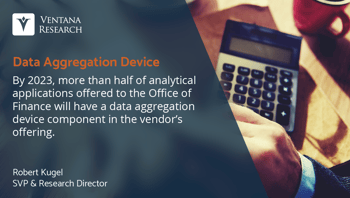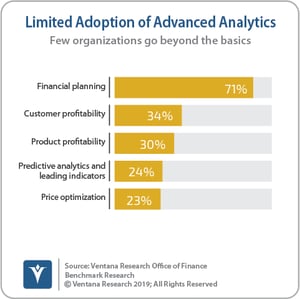An important recent development in software designed for the Office of Finance is the addition of what we’re calling a data aggregation device (DAD) for analytical applications. A DAD automates the collection of data from disparate sources using, for example, application programming interfaces (APIs) and robotic process automation (RPA). With a DAD, users of the analytical application have immediate access to a much broader data set; one that incorporates operational as well as financial data from internal and external sources. The larger data set enables a much more expansive set of analyses than has been feasible in the past because the process of acquiring the data is automated, and the data aggregation is handled in a controlled manner. This control means that data in the system is authoritative, accurate, consistent, complete and secure. The difference between a DAD and a finance data mart is that the former is prebuilt for the specific application, and therefore eliminates this source of implementation costs and offers faster time to value.
Ventana Research asserts that by 2023, more than half of analytical applications offered to the Office of Finance will have a data aggregation device component in the vendor’s offering. Recognizing the value of DADs, Ventana Research gave Workiva our 2018 Digital Innovation award for Wdata, one of the first examples  of a DAD. We recently awarded OneStream the 2020 Digital Innovation award for its Analytical Blend offering, another DAD. DADs assemble a wide spectrum of data from financial, operational and external sources without latency for analysis, alerting and reporting. In doing so, a DAD can expand the frontiers of visibility out to market, industry and economic events and trends, providing a much richer set of performance measures to deliver action-oriented insights to executives and managers.
of a DAD. We recently awarded OneStream the 2020 Digital Innovation award for its Analytical Blend offering, another DAD. DADs assemble a wide spectrum of data from financial, operational and external sources without latency for analysis, alerting and reporting. In doing so, a DAD can expand the frontiers of visibility out to market, industry and economic events and trends, providing a much richer set of performance measures to deliver action-oriented insights to executives and managers.
Without a DAD, data collection typically requires downloading a report from one or more systems into a spreadsheet. Often, the analyst will perform multiple operations on the downloaded data set, such as an arithmetic, logical or format transformation. The spreadsheet is then used to create a report, or its contents are uploaded to another application for further storage, analysis and reporting.
Using spreadsheets to aggregate and prepare data for analysis is a source of inefficiency and ineffectiveness in the Office of Finance. Our Next-Generation Finance Analytics benchmark research finds that when undertaking analyses, two-thirds (68%) of finance departments spend the largest percentage of their time not on analysis but on data preparation activities. Only 28% spend the plurality of their time analyzing data. This is a picture of a situation where the department’s Financial Planning and Analysis (FP&A) organization spends too much time wrangling data, which is inefficient, and therefore does not have enough time creating a broader assortment of analyses or reports, which limits the group’s effectiveness. The research also found that two-thirds of participants say that using spreadsheets makes finance analytics difficult. Our Office of Finance benchmark research finds that while most companies’ finance departments say the data they provide to the rest of the organization is accurate, only 31% describe the information they produce as always timely. If they are able to put less effort into data preparation, financial analysts could allocate that time to what they are paid to do: analysis. Technology is needed to put the “A” back in FP&A.
A DAD can make the use of advanced analytics accessible by giving analysts more time to focus on analytical work. A unified data source facilitates the development of predictive and prescriptive analytics—not just what happened and why, but what is likely to happen and what can be done to achieve a more desirable result. A unified source also makes it easier to apply artificial intelligence through machine learning to facilitate business forecasting, planning and budgeting, and to use those predictions to quickly spot anomalies and provide alerts to responsible parties when results deviate from expectations. Rather than waiting until the end of the month or quarter to take action, organizations can quickly exploit opportunities or mitigate damage in time to improve performance. Our recent Office of Finance benchmark research found that relatively few departments routinely use advanced analytical techniques. Just 24% use predictive analytics and only 30% measure product profitability.
is likely to happen and what can be done to achieve a more desirable result. A unified source also makes it easier to apply artificial intelligence through machine learning to facilitate business forecasting, planning and budgeting, and to use those predictions to quickly spot anomalies and provide alerts to responsible parties when results deviate from expectations. Rather than waiting until the end of the month or quarter to take action, organizations can quickly exploit opportunities or mitigate damage in time to improve performance. Our recent Office of Finance benchmark research found that relatively few departments routinely use advanced analytical techniques. Just 24% use predictive analytics and only 30% measure product profitability.
Because the process of data aggregation is automated and controlled, a DAD makes it possible for analysts to work with a far broader palette of information than accounting data. Historically, financial data has had primacy in measuring performance because it’s been the easiest to access, aggregate and analyze. While financial performance is important, it’s a one-dimensional view of how well an organization is functioning. Having operational data within easy reach enables FP&A groups to make this information more widely available, and to incorporate it into more insightful reporting. This might include input-output types of analyses to assess the relative efficiency or effectiveness of an operating unit over time, or to compare the performance of multiple business units, for instance, revenue per employee hour by location, or total kilowatt hours consumed per unit of output. Finance departments that want to play a more strategic role in their organization must be able to synthesize financial and operational information to provide executives and managers with useful, balanced and timely performance measures.
A DAD also facilitates the use of curated external data in routine analysis. External data includes economic statistics or leading indicators supplied by a third-party provider, industry figures that are only available to members or competitive data contained in public financial filings. External data may be provided by a cloud software vendor as an added service, purchased from a third-party data aggregator or acquired by the company from the internet using an automated web crawler.
The data aggregation requirements of the Office of Finance are more stringent than for general corporate purposes. Access to data either for editing or simply viewing must be controlled for at least two reasons. For one, information such as salaries or tax positions is highly confidential. For another, the ability to change data must be controlled to prevent financial fraud. Administering access controls through permissions to this data must be ironclad and consistent with existing policies, and it must be efficient. It can be time-consuming as well as ineffective to duplicate permissions from finance applications to general purpose ones. Moreover, accounting data is not just a number. There is inherent business logic attached to the number, such as the balancing entry.
I’m not sure the world needs another three-letter acronym, but “DAD” is less than a mouthful. I expect the DAD will become a standard component of business applications, especially for the Office of Finance, because it substantially increases the business value of analytical applications. Buyers of performance management and analytical applications should include a DAD capability in their requests for proposals (RFPs) and their evaluation of vendors’ offerings. FP&A organizations should re-evaluate their mission and priorities in the context of having access to a broader set of readily available information for forecasting, planning, budgeting, analysis and reporting. And analytic software vendors must have DAD capabilities in development if they hope to remain competitive.
Regards
Robert Kugel

 of a DAD. We recently awarded OneStream the
of a DAD. We recently awarded OneStream the  is likely to happen and what can be done to achieve a more desirable result. A unified source also makes it easier to apply artificial intelligence through machine learning to facilitate business forecasting, planning and budgeting, and to use those predictions to quickly spot anomalies and provide alerts to responsible parties when results deviate from expectations. Rather than waiting until the end of the month or quarter to take action, organizations can quickly exploit opportunities or mitigate damage in time to improve performance. Our recent Office of Finance benchmark research found that relatively few departments routinely use advanced analytical techniques. Just 24% use predictive analytics and only 30% measure product profitability.
is likely to happen and what can be done to achieve a more desirable result. A unified source also makes it easier to apply artificial intelligence through machine learning to facilitate business forecasting, planning and budgeting, and to use those predictions to quickly spot anomalies and provide alerts to responsible parties when results deviate from expectations. Rather than waiting until the end of the month or quarter to take action, organizations can quickly exploit opportunities or mitigate damage in time to improve performance. Our recent Office of Finance benchmark research found that relatively few departments routinely use advanced analytical techniques. Just 24% use predictive analytics and only 30% measure product profitability.








